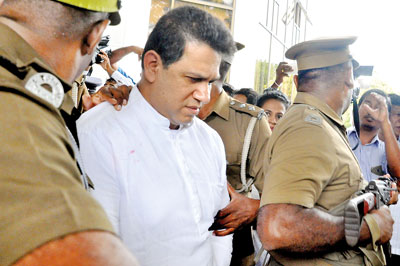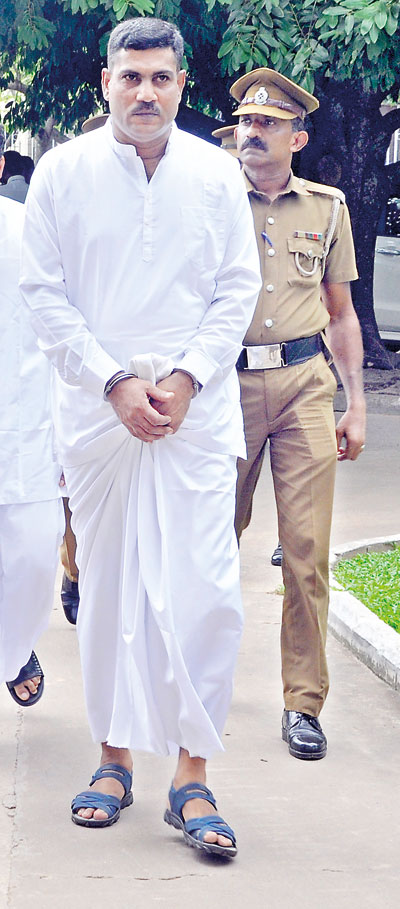News
Former MP Duminda Silva and 3 others guilty as charged, rules Apex Court
View(s):In a detailed decision of fifty one pages, comprehensively dealing with relevant law and facts, a Divisional Bench of the Supreme Court presided over by former Chief Justice Priyasath Dep who retired this week, affirmed the majority decision of the Colombo High Court to impose the death sentence on former parliamentarian Duminda Silva and three other accused associates.

Duminda Silva leaving the Supreme Court. Pix by Priyantha Wickramaarachchi
The first accused who was a police officer assigned to Duminda Silva’s security detail was acquitted and released from all charges levelled against him.
The accused had been charged on 17 penal counts comprising interalia, committing and conspiring to commit murder of four individuals, including Bharatha Premachandra, Dharshana Jayathilaka, Mohamed Azmy and Manimel Kumaraswamy and inflicting gunshot injuries on Mr.Premachandra’s bodyguard Rajapurage Gamini after being members of an unlawful assembly on October 8, 2011, at Walpola, Mulleriyawa.
In affirming the High Court decision, the apex court considered the question as to whether the accused were in fact, members of an unlawful assembly, stating that, if so, the liability will extend not only to offences committed in prosecution of the common object but also to offences which the members of the assembly knew to be likely committed in prosecution of that object. It was further stated that, in deciding as to whether there exists an unlawful assembly or not, events that occurred during the day in question must be considered cumulatively and not in isolation.
Applying these principles to the factual situation that the judges were called upon to consider, the sequence of events on that day relating to the flouting of election laws and prohibited actions by the eleventh accused and his associates was examined. In response to counsel for the eleventh accused (Duminda Silva) arguing that he, along with others in his convoy were merely visiting from one polling center to the other during which journey he had an altercation with the deceased, the Court observed that in fact, the eleventh accused and his the other accused had been acting in clear contravention of election laws.
Due to his interfering with voters at Thamilnadu watte near a polling booth and his remaining in the vicinity of that polling booth from 7.30 am till about 11.30 am on the day in question, the police officer had viewed his presence and that of his group as ‘inappropriate under the circumstances.’ The Court took this as a factor confirming that the eleventh accused had embarked on a ‘prohibited journey ‘in flouting the elections law. Subsequently the eleventh accused and the others with him had become intoxicated; ‘starting from the time the polling commenced and till the time it was drawing to an end, the eleventh accused spent his day, marauding between polling stations with weapons, defying officials discharging their duties, and assaulting and victimizing people…’
Thus, the Court opined that ‘the final act of confrontation that took place around 4 pm between the deceased and the eleventh accused was undoubtedly influenced by these events that took place on that day.’ The group of people who had arrived with the eleventh accused at Rahula Vidyalaya used obscene language, intimidating the crowd gathered there. It was pointed out that the evidence established that the occupants of the van that came behind the eleventh accused’s vehicle displayed around 8 T-56 guns. Dismissing the argument of the defence that a mere a question as to who someone had voted for cannot amount to intimidation, the Court remarked that the same question when asked by a well-known politician on an election day surrounded by a group of people who arrived in brazenly carrying weapons could acquire a completely different hue. The person from whom that question had been asked, had to retreat elsewhere for safety.

The police officer assigned to Duminda Silva’s security detail was acquitted and released from all charges levelled against him
Meanwhile persons who came with the eleventh accused’s convoy had assaulted people gathered there, threatened certain others using fire arms and chased after several others as well. A Special Task Force Officer discharging his duties near the polling station gave evidence that he was threatened with a firearm being pressed to his chest.
Considering these facts, the Supreme Court found that the evidence which had not been controverted, overwhelmingly indicated the sudden escalation of tension that took place with the arrival of the eleventh accused with his convoy and ‘the scare, the threatening and arms-display took place quite boldly while an election was being held on the other side of the road in the polling station’ which militates against the defence contention that the eleventh accused was only supporting and monitoring the area.
If so, the Court observed, ‘there could not have been any necessity for him to travel with an entire battalion of people in 10-15 vehicles, flaunt T56 guns, use obscene language, threaten the civilians and interfere with the officials who were stationed there to maintain peace.’ It is further stated that ‘the conduct and the reaction it generated is wholly incompatible with showing support and unrelated to the purported vigilantism…when the arms and the conduct of the accused persons are factored in, there can be no doubt that they had the illegal objective of intimidating the voters in the area.’
The encounter between the deceased Baratha Lakshxman and the eleventh accused had taken place shortly after the tense situation at the Rahula Vidyalaya. The Court notes that it is an important factor that the distance between the two places was around 500 meters and the time difference was not more than 5 minutes between the two incidents. Assessing the testimony of several witnesses, it is observed that the evidence indicates that the eleventh accused obstructed the vehicle of the deceased Baratha Lakshman, there are clear signs that when fire broke out, the deceased Baratha Lakshman, understanding the difference of fire arm power, attempted to retreat and flee the scene and there is also evidence that the eleventh accused’s pilot vehicle proceeded forward without any hindrance which could only mean that the eleventh accused’s obstruction of the deceased’s convoy was deliberate.
Evaluating legal precedents, the defence argument that the eleventh accused took no active participation in the incident after he suffered a head injury was also dismissed. The Court posed the question to itself; “Where there is clear evidence that a person who is the leader of a group commits the first act in a criminal offence and thereby triggers retaliation, and during the course of that retaliation which he himself triggered, ends up receiving the first injury, should he escape the liability for his actions and intentions?” Weighing these factors, the Court concluded that the evidence clearly established the existence of an unlawful assembly which continued and existed at the time of shooting.
(Please see ‘Focus on Rights’ on page 22 for analysis of the Supreme Court decision)

